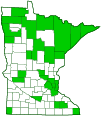broad-headed marsh fly
(Helophilus latifrons)
Conservation • Description • Habitat • Ecology • Distribution • Taxonomy
Conservation Status |
|
|||||||
| IUCN Red List | not listed |
|||||||
| NatureServe | NNR - Unranked SNR - Unranked |
|||||||
| Minnesota | not listed |
|||||||
Description |
||
Broad-headed marsh fly is a medium-sized, brightly colored, flower fly. It occurs in the western, north-central, and northeastern United States, in southern Canada, and in the mountainous regions of Mexico. It is mostly absent from the southeast and south-central United States. It was once very common, but its numbers have declined significantly, as much as 80% to 90%. However, it is still widespread and relatively common. It is the most common Helophilus species in Minnesota. The larvae, known as rat-tailed maggots, are aquatic and feed on decaying vegetation. Adults have been recorded from May 7 to September 10 in Minnesota. They feed on flower nectar. Adults are robust and 7⁄16″ to ⅝″ (10.6 to 16.6 mm) in length. The head is hemispherical, not flattened. There are two large compound eyes on the sides of the head and three small simple eyes (ocelli) in a triangle on top of the head. The compound eyes are bare, with no erect hairs, and are narrowed abruptly at the top of the face. They do not meet at the top of the head in either sex. On the male they abruptly converge slightly at the top, but the top of the head (vertex) is wider than the base of the antennal pits. The face is entirely covered with hairs except for a bare, shiny, yellow or reddish-yellow vertical line in the middle. The upper part of the face (frons) is covered with entirely yellow hairs. Both sexes have black hairs on the vertex and only on the vertex. On the female the space between the ocelli and the antennae bases is covered with yellow hairs. The antennae are short and have three segments, the scape at the base, the pedicel, and the flagellum. The scape and pedicel are black. At the base of the flagellum there is a long, forward-pointing bristle (arista) on the upper side. The thorax is covered with erect yellow hairs. The large front portion (scutum) is brownish-black and has four bold longitudinal stripes. The two middle stripes may be white or yellow. The small rear part of the thorax (scutellum) is yellowish and more or less translucent. There are no bristles on the scutum or scutellum. The small plate in the shoulder area just behind the head (postpronotum) is bare, with no hairs or bristles. Unfortunately, this is not visible without first removing the fly’s head. The abdomen on the male has four visible segments. It is black with a yellow or white band on each segment. The first segment is very narrow. The band on the second segment is broad, yellow, and incomplete, interrupted in the middle. The band on the third segment is broad, yellow, and is usually connected in the middle by a narrow pale yellow or white extension. The band on the fourth segment is pale yellow or white, is arced on each side, and is complete, meeting in the middle. On the female the abdomen has five visible segments. The bands are similar but variable. The wings are mostly clear. The pigmented region (stigma) near the leading edge of the wing is a diffuse smoky brown patch more than twice as long as wide. It does not resemble a cross vein. The marginal cell R1 is closed, R3 is open. The anal is cell closed before the border of the wing. |
||
Size |
||
Total length: 7⁄16″ to ⅝″ (10.6 to 16.6 mm) |
||
Similar Species |
||
Habitat |
||
|
||
Ecology |
||
Season |
||
May 7 to September 10 |
||
Behavior |
||
|
||
Life Cycle |
||
|
||
Larva Food |
||
Rotting vegetation |
||
Adult Food |
||
Flower nectar |
||
Distribution |
||||
|
Sources Telford, Horace S.. (1939). The Syrphidae of Minnesota. University of Minnesota. Minnesota Agricultural Experiment Station. |
|||
| 9/4/2022 | ||||
Occurrence |
||||
|
||||
Taxonomy |
|||
Order |
Diptera (Flies) | ||
Suborder |
Brachycera | ||
Infraorder |
Cyclorrhapha | ||
| Zoosection | Aschiza | ||
Family |
Syrphidae (Hover Flies) | ||
Subfamily |
Eristalinae (Drone Flies and Allies) | ||
Tribe |
Eristalini (Rat-tail Maggot Flies) | ||
| Subtribe | Helophiliina | ||
Genus |
Helophilus (marsh flies) | ||
| Subgenus | Helophilus | ||
Synonyms |
|||
Elophilus latifrons |
|||
Common Names |
|||
broad-headed marsh fly |
|||
Glossary
Arista
A large bristle on the upper side of the third segment of the antenna of a fly. Plural: aristae.
Frons
The upper front part of an insect’s face, roughly corresponding to the forehead.
Ocellus
Simple eye; an eye with a single lens. Plural: ocelli.
Scutellum
The exoskeletal plate covering the rearward (posterior) part of the middle segment of the thorax in some insects. In Coleoptera, Hemiptera, and Homoptera, the dorsal, often triangular plate behind the pronotum and between the bases of the front wings. In Diptera, the exoskeletal plate between the abdomen and the thorax.
Scutum
The forward (anterior) portion of the middle segment of the thorax (mesonotum) in insects and some arachnids.
Stigma
In plants, the portion of the female part of the flower that is receptive to pollen. In Lepidoptera, an area of specialized scent scales on the forewing of some skippers, hairstreaks, and moths. In other insects, a thickened, dark, or opaque cell on the leading edge of the wing.
vertex
The upper surface of an insect’s head.
Visitor Photos |
|||||
Share your photo of this insect. |
|||||
| This button not working for you? Simply email us at info@MinnesotaSeasons.com. Attach one or more photos and, if you like, a caption. |
|||||
Greg Watson |
|||||
I was riding my bike along the Wagon Wheel Trail in La Crescent this morning and I was able to get these two pictures of a [Broad-headed] Marsh Fly. A first time for me on seeing one. It is on a Blue vervain, verbena hastata. |
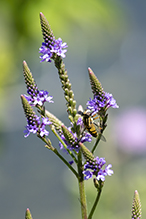 |
||||
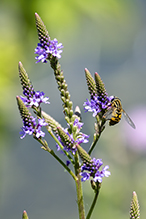 |
|||||
MinnesotaSeasons.com Photos |
|||||
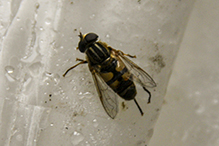 |
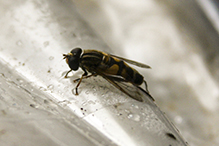 |
||||
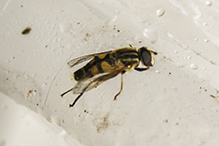 |
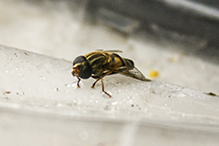 |
||||

Slideshows |
||

Visitor Videos |
|||
Share your video of this insect. |
|||
| This button not working for you? Simply email us at info@MinnesotaSeasons.com. Attach a video, a YouTube link, or a cloud storage link. |
|||
Other Videos |
|||


Created: 9/4/2022
Last Updated:
